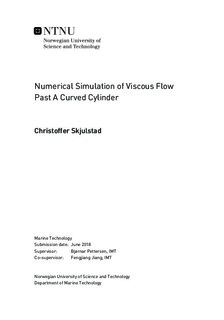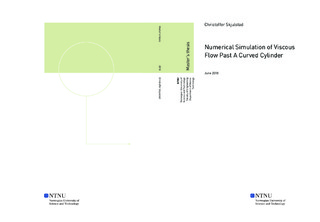Numerical Simulation of Viscous Flow Past A Curved Cylinder
| dc.contributor.advisor | Pettersen, Bjørnar | |
| dc.contributor.advisor | Jiang, Fengjiang | |
| dc.contributor.author | Skjulstad, Christoffer | |
| dc.date.accessioned | 2018-09-25T14:01:45Z | |
| dc.date.available | 2018-09-25T14:01:45Z | |
| dc.date.created | 2018-06-25 | |
| dc.date.issued | 2018 | |
| dc.identifier | ntnudaim:18919 | |
| dc.identifier.uri | http://hdl.handle.net/11250/2564457 | |
| dc.description.abstract | In the present Master thesis three-dimensional viscous flow simulations of flow past a curved circular cylinder is investigated by utilization of the open source Computational Fluid Dynamics (CFD) code OpenFOAM. The focus of the present study has been to establish a basic setup for analysing the curved cylinder flow problem in OpenFOAM by verification with recent unpublished Direct Numerical Simulations (DNS) of the same problem. The geometry considered is defined by three parts; a curved quarter-of-ring cylinder with a radius of curvature of 12.5D, a horizontal straight extension of length 10D and a vertical straight extension of 24D, where D is the cylinder diameter. Straight extension lengths are chosen to eliminate free-end effects according to recent research. The plane of curvature is aligned with the incoming flow and directed towards the concave face of the curved part. Uniform inflow at $Re=200$ and $500$ is considered and the solution is compared to DNS results by means of analysing near wake flow details. The OpenFOAM solution captures overall wake topology similar to the DNS. Shedding frequencies are close to DNS however reduced slightly due to a stronger spanwise flow. Details in the transitional region around the intersection between the curved and vertical parts for $Re=500$ are not captured correctly by the present study. Mean and root-mean-square values of drag and lift forces are overpredicted by the OpenFOAM solution. The tendency increases for larger $Re$ and is owed to the relatively low grid resolution near the cylinder compared to DNS. Three variants of sheared inflow conditions are investigated. A linear shear profile is considered both for positive and negative shear rate with Reynolds number extrema of $Re=200$ and $Re=500$. An additional negative shear is considered for extrema of $Re=700$ and $Re=200$. Three-dimensionalities in the freestream introduces additional spanwise flow leading to different wake topologies for negative and positive shear. Positive shear exhibits cellular vortex shedding along the vertical extension as seen for straight cylinders in shear flow. Interactions between upwash from the curved part and downwash from shear results in a high-frequency shedding region placed along the span of the vertical extension. | |
| dc.language | eng | |
| dc.publisher | NTNU | |
| dc.subject | Marin teknikk, Marin hydrodynamikk | |
| dc.title | Numerical Simulation of Viscous Flow Past A Curved Cylinder | |
| dc.type | Master thesis |
Tilhørende fil(er)
Denne innførselen finnes i følgende samling(er)
-
Institutt for marin teknikk [3421]

